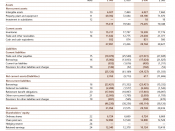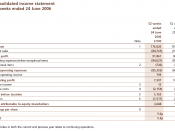Strategic Management Thorntons Case Study
THORNTONS PLC
CASE STUDY
STRATEGIC MANAGEMENT COURSE
�
OUTLINE
Executive Summary 2
1.0. Introduction 3
1.1. Historical Background 3
1.2. Current Status 5
1.2.1 Sales Breakdown 5
1.2.2 Stock Information 6
1.2.3 Current Strategy 8
1.2.4 Improved Margin and Costs 8
1.2.5 Thorntons Café 9
2.0. Case Analysis 10
2.1. Scope of Business 10
2.2. The Five Forces Framework 10
2.3. Strategic Capabilities 12
2.3.1 Resources 12
2.3.2 Competencies 12
2.4. Cost Efficiency 13
2.5. Competitive Advantage 13
2.6. Strategic Choice 13
2.7. The Value Network 14
2.7.1 Suppliers 14
2.7.2 Distribution 14
2.8. Critical Success Factors 14
2.9. PESTEL Analysis 15
2.10. Strategy Development Directions 16
2.11. Strategy Change 17
2.12. Methods of Strategy Development Analysis 18
2.13. Conclusion 19
2.14. Recommendations 19
Appendix A : Profit and Sales from 1994-2006 20
Appendix B : UK Confectionary Market Breakdown 20
Appendix C : Consolidated Financial Statements 21
�
EXECUTIVE SUMMARY
Throughout the years, starting since 1911, Thorntons, the UK's largest manufacturer and retailer of specialist chocolates had followed a strategy of in house manufacture, retailing largely through the company's own shops, and to a lesser extent, through franchising.
This policy presented the company with the difficulties of economically meeting seasonal demand variations in the chocolates, especially Christmas and Easter seasons.
The company also did attempt both product and market development, but never the less, the profits were steady or failing along the last 12 years, product development was following contradicting directions according to several CEO strategies, will market development was a complete failure either in the US or Europe, due to major failures in acquisitions and failure of culture fitting.
By year, 2006, Thornton owned 369 shops, and franchised 216 shops, with sales income 176.6 ⤠Million, with operating profit 5.2 ⤠million, a...


